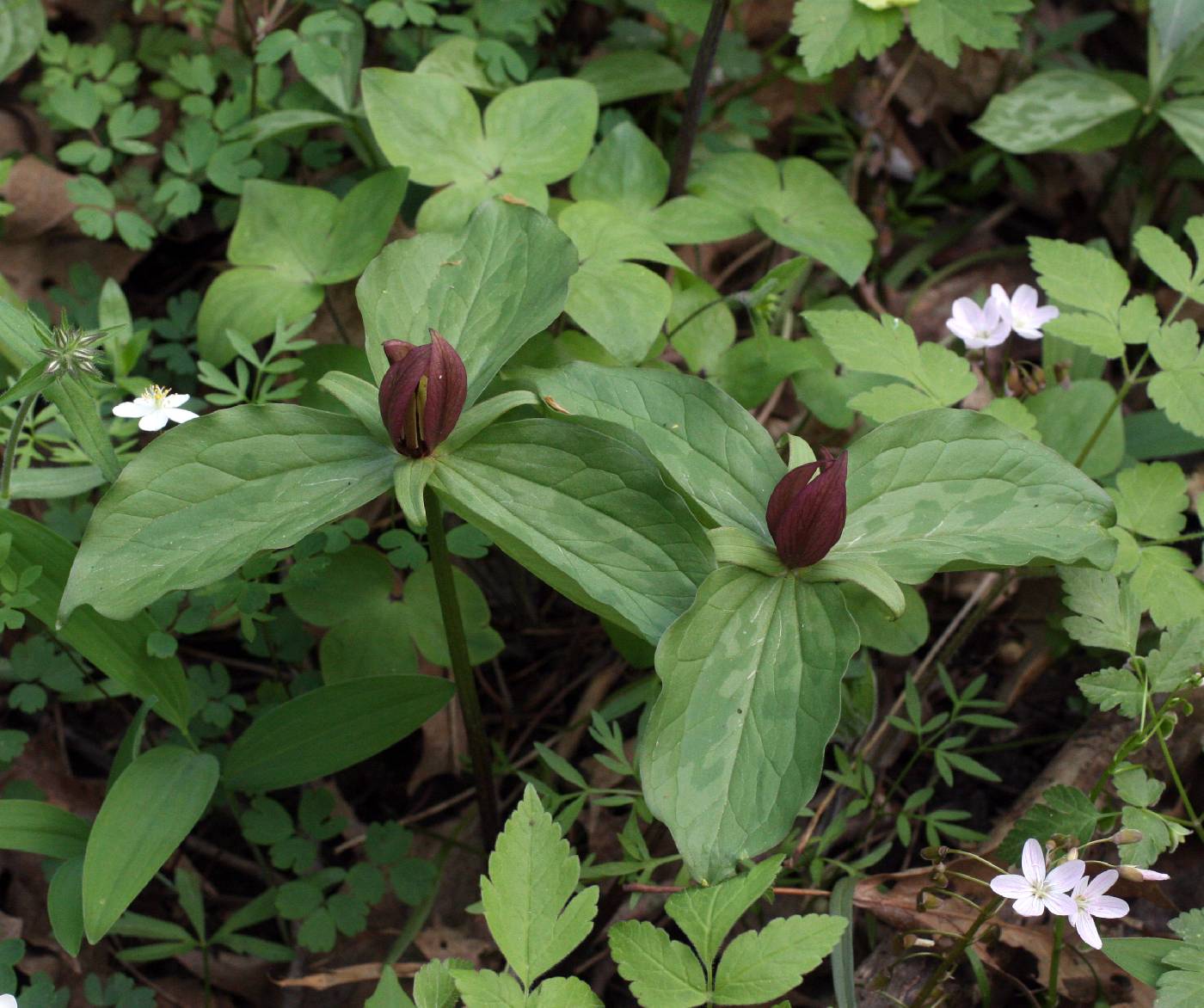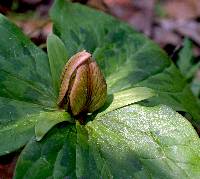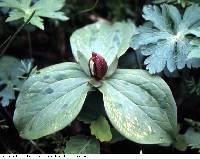|
|
|
|
Family: Melanthiaceae
toadshade
|
Rhizomes horizontal, brownish, thick, praemorse, fleshy. Scapes 1-3, round in cross section, 0.8-2.5 dm, slender to stout, glabrous. Bracts held well above ground, sessile; blade green to bluish green, strongly to sparsely mottled, mottling becoming obscure with age, oval to suborbicular, 4-10 × 2-8 cm, base broadly attached, apex rounded-acuminate to bluntly parallel sided-acuminate (rounded basally to its broad attachment). Flower erect, odor pungent, spicy; sepals displayed above bracts, spreading, green, variously streaked with maroon, lanceolate-oblanceolate, 9-35 × 4-8 mm, margins entire, apex rounded-acuminate; petals long-lasting, erect, ± connivent, ± concealing stamens and ovary, maroon, brownish maroon, green, or yellowish green, not spirally twisted, oblanceolate to elliptic, occasionally almost orbicular, 1.7-3.5 × 0.7-2 cm, thick-textured, narrowed near basal attachment (but not truly clawed), margins entire, apex gradually rounded-tapered to acute; stamens straight, 10-23 mm; filaments red-purple, 2-5 mm, dilated basally; anthers erect, straight, gray-purple, 9-16 mm, thick, dehiscence introrse; connectives purplish brown, straight, projecting 2-5+ mm beyond anther sacs; ovary greenish white basally, purple distally, ovoid to globose, 6-angled, pyramidally narrowed to stigmas, 4-8.5 mm; stigmas erect, divergent-recurved, distinct, purple, subulate, 1-5 mm, ± fleshy. Fruits baccate, dark greenish purple, odorless, subglobose, 6-angled, angles somewhat winglike, pulpy, not juicy. 2n = 10. Flowering spring (Mar--early May). Rich woodlands, limestone districts, calcareous soils, floodplains, riverbanks, clayey alluvium, less fertile soils, high, dry limestone woods, persists under light pasturing, in fencerows and brushy areas after lumbering; 100--300 m; Ala., Ark., Ill., Ind., Kans., Ky., Md., Mich., Mo., N.Y., N.C., Ohio, Okla., Pa., Tenn., Va., W.Va. Trillium sessile is rather uniform throughout its range, with few color forms.
Perennial herb with a short, stout rhizome stem 10 - 30 cm tall Flowers: single, upright, stalkless, with six distinct tepals, bad-smelling. Stamens six, alternating in two whorls of three. Sepals: three, persistent, streaked with maroon, 9 mm - 3.5 cm long, 4 - 8 mm wide, more or less equal to the petals, lance- to egg-shaped, spreading or ascending. Petals: three, maroon (sometimes green to yellow), 1.7 - 3.5 cm long, 0.7 - 2 cm wide, narrowly to broadly elliptic with a tapering base, ascending, more or less concealing the stamens and ovary, long-lasting. Fruit: a many-seeded berry, dark greenish purple, nearly spherical, six-angled (somewhat wing-like), pulpy. Seeds many, elliptic. Similar species: This Trillium species is easily distinguished from the others by having stalkless leaves and a stalkless flower. Flowering: mid-April to mid-May Habitat and ecology: Rare in the Chicago Region, found in rich moist woods. Occurence in the Chicago region: native Notes: Trilliums do not actually have true leaves or stems above the ground. The underground rhizome produces scale-like leaves called cataphylls. The aboveground leaf-like structures are bracts that subtend the flower, but these are internally and externally similar to leaves and function in photosynthesis. Many authors will refer to them as leaves. Etymology: Trillium comes from the Greek word trilix, meaning triple, referring to how all the plant parts occur in threes. Sessile means stalkless. Author: The Morton Arboretum Rhizome very thick and stout; stem 1-3 dm at anthesis; lvs broadly ovate to rotund, sessile, rounded, broadly obtuse or obscurely cuspidate, usually only inconspicuously or not at all mottled, seldom over 9 cm at anthesis; fl sessile, foetid; sep spreading or ascending, lance-ovate, 2-3 cm; pet normally maroon (yellow or green), ascending, narrowly to broadly elliptic, narrowed to a sessile base, equaling or slightly longer than the sep and twice as long as the stamens; filaments (2-)3-4(-5) mm, less than half as long as the introrse anthers, the flattened connective with a prolongation nearly as long as the filament; stigmas 1.5-2 times as long as the subglobose, sharply 6-angled or -winged ovary; 2n=10. Rich moist woods; w. Pa. and sw. N.Y. to s. Mich., Ill., Mo., and e. Kans., s. to Md., Va., n. N.C., n. Ala., and n. Ark. Apr., May. Gleason, Henry A. & Cronquist, Arthur J. 1991. Manual of vascular plants of northeastern United States and adjacent Canada. lxxv + 910 pp. ©The New York Botanical Garden. All rights reserved. Used by permission. |




